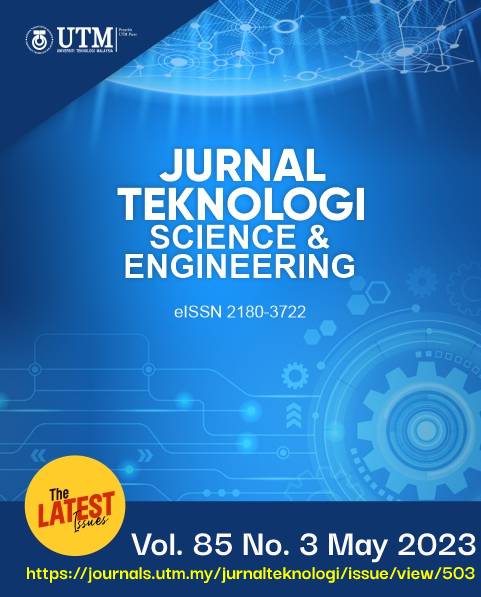ON THE SZEGED INDEX AND ITS NON-COMMUTING GRAPH
DOI:
https://doi.org/10.11113/jurnalteknologi.v85.19221Keywords:
Szeged index, non-commuting graph, dihedral groups, generalized quaternion groups, quasidihedral groupsAbstract
In chemistry, the molecular structure can be represented as a graph. Based on the information from the graph, its characterization can be determined by computing the topological index. Topological index is a numerical value that can be computed by using some algorithms and properties of the graph. Meanwhile, the non-commuting graph is a graph, in which two distinct vertices are adjacent if and only if they do not commute, where it is made up of the non-central elements in a group as a vertex set. In this paper, the Szeged index of the non-commuting graph of some finite groups are computed. This paper focuses on three finite groups which are the quasidihedral groups, the dihedral groups, and the generalized quaternion groups. The construction of the graph is done by using Maple software. In finding the Szeged index, some of the previous results and properties of the graph for the quasidihedral groups, the dihedral groups, and the generalized quaternion groups are used. The generalisation of the Szeged index of the non-commuting graph is then established for the aforementioned groups. The results are then applied to find the Szeged index of the non-commuting graph of ammonia molecule.
References
Gutman, I. and Polansky, O. E. 1986. Mathematical Concepts in Organic Chemistry. Springer-Verlag Berlin Heidelberg.
Basak, S. C., Niemi, G. J., and Veith, G. D. 1991. Predicting Properties of Molecules using Graph Invariants. Journal of Mathematical Chemistry. 1: 243-272. Doi: https://doi.org/10.1007/bf01200826.
Ali, P., Kirmani, S. A. K., Al Rugaie, O., and Azam, F. 2020. Degree-based Topological Indices and Polynomials of Hyaluronic Acid-curcumin Conjugates. Saudi Pharmaceutical Journal. 28(9): 1093-1100. https://doi.org/10.1016/j.jsps.2020.07.010.
Humphreys, J. F., Humphreys, M. J., and Liu, Q. 1996. A Course in Group Theory. Vol. 6. Oxford University Press on Demand. Doi: https://doi.org/10.2307/2005904.
Raza, Z. and Faizi, S. 2013. Non-commuting Graph of Finitely Presented Group. Sci. Int. (Lahore). 25 (4): 883-885.
Wiener, H. 1947. Structural Determination of Paraffin Boiling Points. Journal of the American Chemical Society. 69(1): 17-20. Doi: https://doi.org/10.1021/ja01193a005.
Gutman, I. and Trinajstic ́, N. 1972. Graph Theory and Molecular Orbitals. Total φ-electron Energy of Alternant Hydrocarbons. Chemical Physics Letters. 17(4): 535-538. Doi: https://doi.org/10.1016/0009-2614(72)85099-1.
Gutman, I., Togan, M., Yurttas, A., Cevik, A. S. and Cangul, I. N. 2018. Inverse Problem for Sigma Index. MATCH Commun. Math. Comput. Chem. 79(2): 491-508.
Xu, K., Gao, F., Das, K. C. and Trinajstic ́, N. 2019. A Formula with its Applications on the Difference of Zagreb Indices of Graphs. Journal of Mathematical Chemistry. 57(6): 1618-1626. Doi: https://doi.org/10.1007/s10910-019-01025-0.
Plav ̌sic ́, D., Nikolic ́, S., Trinajstic ́, N., and Mihalic ́, Z. 1993. On the Harary Index for the Characterization of Chemical Graphs. Journal of Mathematical Chemistry. 12(1): 235-250. Doi: https://doi.org/10.1007/BF01164638.
Xu, K. and Das, K. C. 2011. On Harary Index of Graphs. Discrete Applied Mathematics. 159(15): 1631-1640. Doi: https://doi.org/10.1016/j.dam.2011.06.003.
Gutman, I. and Dobrynin, A. A. 1998. The Szeged Index–A Success Story. Graph Theory Notes NY. 34: 37-44.
Gutman, I., Popovic, L., Khadikar, P., Karmarkar, S., Joshi, S. and Mandloi, M. 1997. Relations between Wiener and Szeged Indices of Monocyclic Molecules. MATCH Commun. Math. Comput. Chem. 35: 91-103.
Nadjafi-Arani, M. J., Khodashenas, H. and Ashrafi, A. 2011. On the Differences between Szeged and Wiener Indices of Graphs. Discrete Mathematics. 20: 2233-2237. Doi: https://doi.org/10.1016/j.disc.2011.06.019.
Bonamy, M., Knor, M., Luz ̌ar, B., Pinlou, A. and S ́krekovski, R. 2017. On the Difference between the Szeged and the Wiener Index. Applied Mathematics and Computation. 312: 202-213.
Doi: https://doi.org/10.1016/j.amc.2017.05.047.
Wang, G., Li, S., Qi, D. and Zhang, H. 2018. On the Edge-Szeged Index of Unicyclic Graphs with Given Diameter. Applied Mathematics and Computation. 336: 94-106.
Pattabiraman, K., & Kandan, P. 2018. Weighted Szeged Index of Graphs. Bulletin Of International Mathematical Virtual Institute. 8(1): 11-19. https://doi.ord/ 10.7251/BIMVI1801011P.
Liu, H. 2022. On Revised Szeged Index of a Class of Unicyclic Graphs. Discrete Mathematics, Algorithms and Applications. 14(02): 2150115. https://doi.org/10.1142/S1793830921501159.
Mahmoud, R. 2018. Energy and Laplacian Energy of Graphs Related to a Family of Finite Groups. Ph.D. Thesis. Universiti Teknologi Malaysia.
Rosen, K. H. and Krithivasan, K. 2012. Discrete Mathematics and Its Applications: With Combinatorics and Graph Theory. Tata McGraw-Hill Education.
Bondy, J. A and Murty, J. A. 1976. Graph Theory with Applications. Vol.210 290. Macmillan London.
Samaila, D., Abba, B. I. and Pur, M. P. 2013. On the Conjugacy Classes, Centers and Representation of the Groups S_n and D_n. International Journal of Pure and Applied Sciences and Technology. 15 (1): 87-89.
Roman, S. 2011. Fundamentals of Group Theory: An Advanced Approach. Springer Science & Business Media.
Dummit, D. S. and Foote, R. M. 2004. Abstract Algebra. Vol. 3. Wiley Hoboken.
Abdollahi, A., Akbari, S. and Maimani, H. 2006. Non-commuting Graph of a Group. Journal of Algebra. 298(2): 468-492. Doi: https://doi.org/10.1016/j.jalgebra.2006.02.015.
Thakkar, A. J. 2017. Quantum Chemistry. Morgan & Claypool Publisher.
Zeldin, M. 1966. An Introduction to Molecular Symmetry and Symmetry Point Groups. Journal of Chemical Education. 43(1): 17. Doi: https://doi.org/10.1021/ed043p17.
Aruldhas, G. 2007. Molecular Structure and Spectroscopy. PHI Learning Pvt. Ltd.
Downloads
Published
Issue
Section
License
Copyright of articles that appear in Jurnal Teknologi belongs exclusively to Penerbit Universiti Teknologi Malaysia (Penerbit UTM Press). This copyright covers the rights to reproduce the article, including reprints, electronic reproductions, or any other reproductions of similar nature.
















